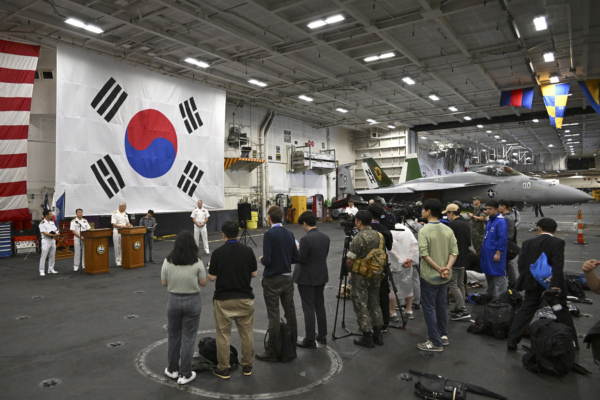On Saturday, June 29th, the United States concluded its first multi-domain exercise in the East China Sea with Japan and South Korea. Faced with increasing regional threats from North Korea and China, the U.S. is further strengthening and focusing on its security partnerships with key Asian allies.
The three-day “Freedom Edge” exercise, which was more complex than previous drills, included both air and maritime exercises aimed at enhancing joint ballistic missile defense, anti-submarine warfare, surveillance, and other skills and capabilities.
According to reports from the Associated Press, this exercise also aimed to improve the shared missile warning capabilities among the participating countries. With North Korea conducting tests of seemingly more advanced systems, this defense capability has become increasingly crucial.
Ridzwan Rahmat, an analyst with defense intelligence company Janes based in Singapore, highlighted that besides Australia, Japan and South Korea are the only cooperative partners of the U.S. in the region with advanced military capabilities to integrate actions with the U.S. quickly in response to threats.
“This kind of trilateral exercise is designed to enhance interoperability among the three forces, enabling them to better operate as a cohesive fighting force,” Rahmat explained.
The U.S., Japan, and South Korea agreed to hold this exercise during the Camp David Summit in August 2023. The announcement was made during the Shangri-La Dialogue in Singapore on June 2nd, where defense ministers of the three countries were present.
On Wednesday, June 26th, South Korean President Moon Jae-in visited the USS Roosevelt aircraft carrier in Busan, becoming the first sitting Korean president to visit an American aircraft carrier since 1994.
Moon stated, “Tomorrow, the USS Roosevelt will depart to join the ‘Freedom Edge,’ the first trilateral multi-domain military exercise between the U.S., South Korea, and Japan. Our shared values of freedom and democracy, along with our alliance, will become another strong deterrence.”
The day after Moon’s visit, North Korea claimed to have successfully test-fired a multiple-warhead missile. South Korean military authorities stated that joint U.S. and South Korean assessments deemed the missile launch unsuccessful.
South Korea and Japan host around 80,000 U.S. troops, making them the two largest host countries in East Asia. Despite historical tensions, both countries have set aside past disputes to form a strong triangle of containment against North Korea and China with the U.S.
Euan Graham, a defense analyst at the Australian Strategic Policy Institute, noted that the Biden administration has long been working to enhance cooperation between South Korea and Japan.
As tensions rise with North Korea’s provocations and China’s growing assertiveness, Japan and South Korea have put aside issues such as territorial disputes, historical grievances, and trade restrictions to form a united front with the U.S. in East Asia.
Graham emphasized, “This is a significant achievement facilitated by the U.S. government’s regional policy.”
The approach of Japanese Prime Minister Fumio Kishida to increase defense spending and collaborate with South Korea has garnered public support in Japan. Despite internal pressures in South Korea, Moon Jae-in has remained steadfast in his alliance with the U.S.
Heigo Sato, an international politics professor and security expert at Takushoku University, remarked, “Under the leadership of Moon Jae-in’s government, Korea’s shift towards improving relations with Japan is of significant importance.”
South Korean officials recently expressed their desire to sign a formal security framework agreement with the U.S. and Japan this year to solidify measures for collective defense against potential North Korean aggression.
Graham stated that under Biden’s leadership, the U.S. is seeking to consolidate its alliance system through increasingly complex exercises and diplomatic agreements.
“They are institutionalizing these cooperative habits as actively as possible, not only in response to challenges from adversaries but also considering the potential government uncertainties that the November elections may bring,” he added.
Despite severe international sanctions, North Korean leader Kim Jong Un’s weapon programs continue to advance, raising tensions on the Korean Peninsula to the highest levels in years.
Meanwhile, China has been aggressively amassing nuclear and conventional weapons, boasting the world’s largest navy. China insists on territorial claims over Taiwan and much of the South China Sea and increasingly resorts to military means to assert these claims.
As Russia continues its war against Ukraine, China and North Korea, two of Russia’s closest allies facing broad Western sanctions, recently signed a mutual defense treaty in Pyongyang. This agreement stipulates mutual aid in case of attacks, causing concern among other countries in the region.
While China has more warships, it still lags behind the U.S. Navy, which boasts 11 aircraft carriers compared to China’s three. Aircraft carriers serve as a potent tool for projecting power far from a nation’s shores. Leveraging these powerful assets, the U.S. can monitor global situations effectively.
Following the exercises in the East China Sea with Japan and South Korea, the USS Roosevelt is set to sail to the Middle East to help protect vessels passing through the Red Sea from attacks by Houthi rebels in Yemen.
Amid China’s expanding ambitions in the Indo-Pacific, the Biden administration’s top priority is establishing a robust network of regional security partnerships, not only with Japan and South Korea but also with Australia, the Philippines, Taiwan, and other countries in the region.
Rahmat noted, “Although the Chinese navy has more warships, one of its weaknesses is the lack of a friendly port network, hindering operations in the event of conflict. Recognizing this advantage, the U.S. is intensifying efforts to enhance cooperation across the entire region.”

